Amaretti Cheesecake Recipe: A Decadent and Classic Dessert
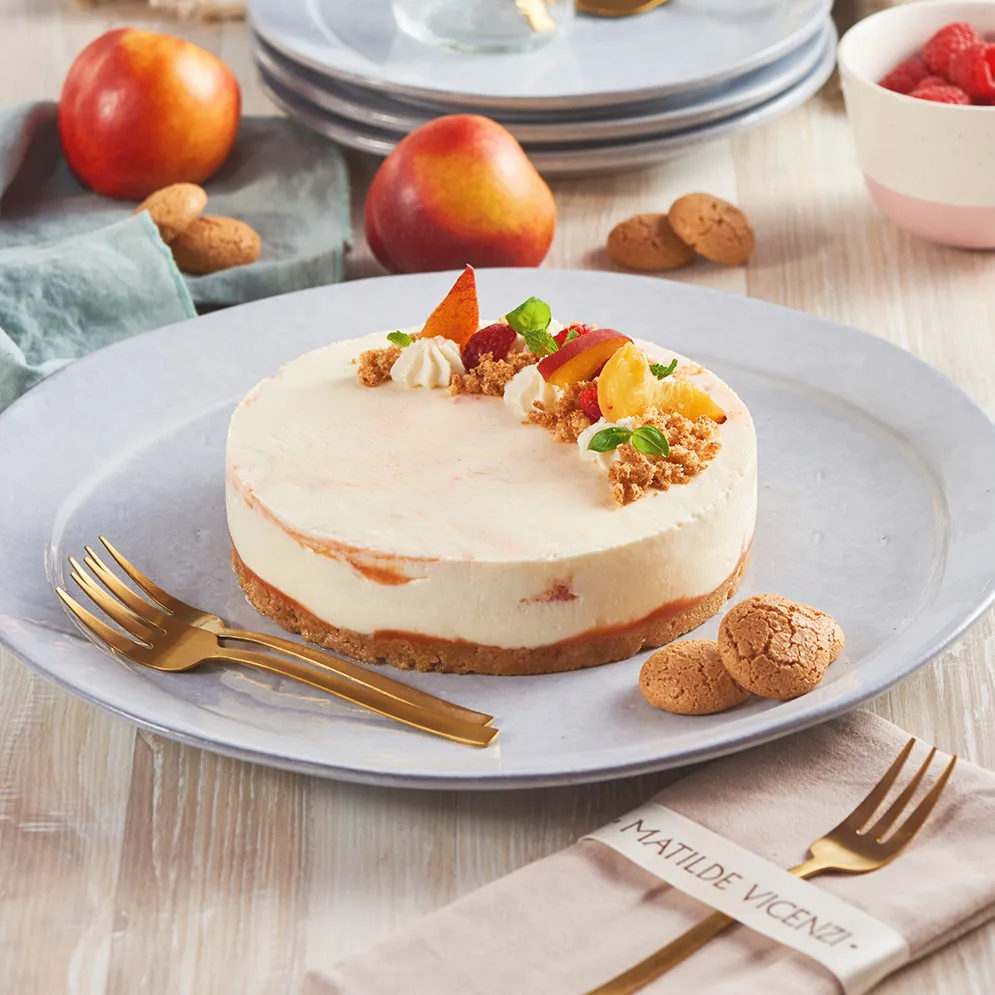
Amaretti Cheesecake recipe is a classic dessert that combines the rich and creamy flavor of cheesecake with the delicate almond flavor of Amaretti cookies. This dessert is perfect for any occasion, from a formal dinner party to a casual family gathering. In this article, we’ll explore the cultural significance and history of Amaretti Cheesecake, as well as provide step-by-step instructions, ingredients, and tips for making it at home. We’ll also include information about the nutrients and calories in each slice, so you can enjoy this indulgent dessert guilt-free. Amaretti Cheesecake Recipe Cultural Significance and History Amaretti cookies have a long history in Italy, dating back to the Renaissance period. These small, crunchy cookies are made from almonds, sugar, and egg whites, and were originally created as a way to use up leftover almond paste from making marzipan. Over time, Amaretti cookies became a popular dessert all over Italy, and their popularity spread to other parts of the world. Cheesecake also has a rich history, dating back to ancient Greece. The Greeks would often make a simple cheesecake by mixing cheese with honey and wheat. Cheesecake later became popular in Europe during the Middle Ages, and in the United States during the early 1900s. Amaretti Cheesecake is a modern twist on these classic desserts, combining the nutty flavor of Amaretti cookies with the creamy texture of cheesecake. Amaretti Cheesecake Recipe Ingredients For the crust: For the filling: Amaretti Cheesecake Recipe Instructions Amaretti Cheesecake Recipe Tips Nutrients and Calories One slice of Amaretti Cheesecake (1/12 of the recipe) contains approximately: While Amaretti Cheesecake is certainly not a low-calorie dessert, it can be enjoyed in moderation as part of a balanced diet. The high fat content is due to the cream cheese and butter used in the recipe, but these ingredients can be substituted for lower-fat options if desired. Summary Amaretti Cheesecake is a delicious and indulgent dessert that combines the classic flavors of Amaretti cookies and cheesecake. This dessert has a long history in Italy and is now enjoyed all over the world. Making Amaretti Cheesecake at home is easy, and the recipe provided in this article includes step-by-step instructions and tips for ensuring the cheesecake turns out perfectly. While Amaretti Cheesecake is not a low-calorie dessert, it can be enjoyed in moderation as part of a balanced diet. So next time you’re looking for a decadent dessert, try making Amaretti Cheesecake – your taste buds will thank you! Conclusion Amaretti Cheesecake is a classic and indulgent dessert that combines the nutty flavor of Amaretti cookies with the creamy texture of cheesecake. This dessert has a long history in Italy and is now enjoyed all over the world. Making Amaretti Cheesecake at home is easy, and the recipe provided in this article includes step-by-step instructions and tips for ensuring the cheesecake turns out perfectly. While Amaretti Cheesecake is not a low-calorie dessert, it can be enjoyed in moderation as part of a balanced diet. So why not give this delicious dessert a try? Your taste buds will thank you! More Italian Recipes Follow Us on Instagram
Chocolate Amaretti Cookies Recipe: Decadent and Delicious
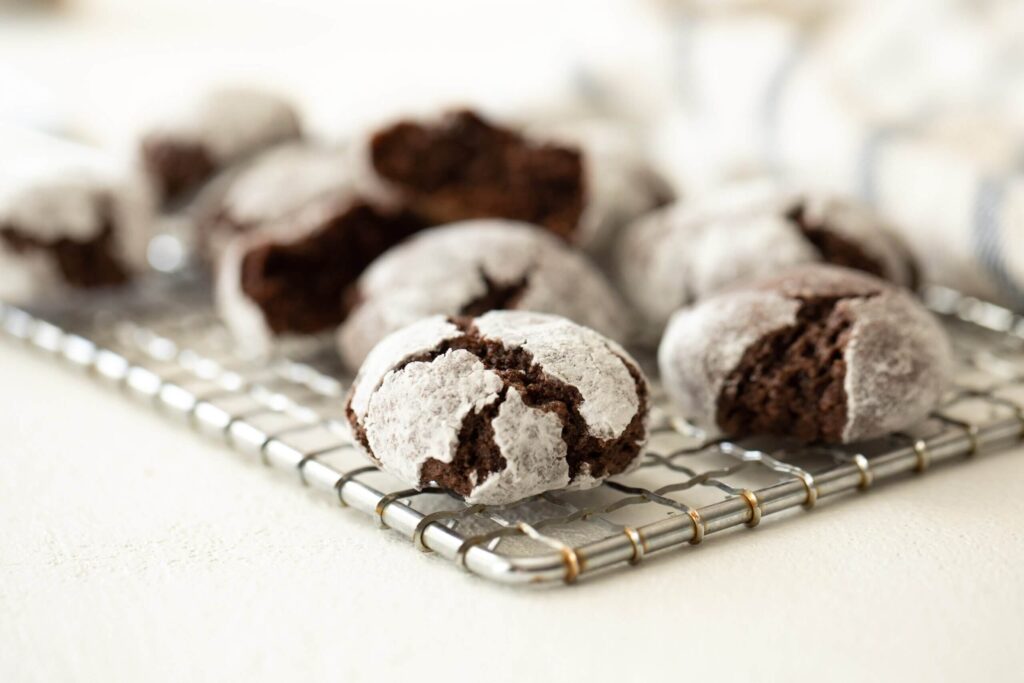
Amaretti cookies recipe are a traditional Italian treat that has been enjoyed for centuries. They are crunchy on the outside and chewy on the inside, and have a distinct almond flavor that is hard to resist. However, for those who love chocolate, there is an even more decadent version of this classic cookie: Chocolate Amaretti Cookies. These cookies combine the best of both worlds – the nutty flavor of Amaretti cookies with the rich, indulgent taste of chocolate. In this article, we will explore the history and cultural significance of Chocolate Amaretti Cookies, as well as provide step-by-step instructions and tips for making the perfect batch at home. Chocolate Amaretti Cookies Cultural Significance and History Amaretti cookies have been a part of Italian culture for centuries. They were first made in the town of Saronno in Lombardy, Northern Italy, and were originally made with apricot kernels. However, due to the toxicity of apricot kernels, almonds have since become the preferred ingredient. Today, Amaretti cookies are enjoyed throughout Italy and are often used as an ingredient in other desserts, such as tiramisu. Chocolate Amaretti Cookies are a newer variation of the classic cookie. They add chocolate to the mix, which takes the cookies to a whole new level of indulgence. They are perfect for those who have a sweet tooth but also love the nutty flavor of Amaretti cookies. Chocolate Amaretti Cookies Cooking Time The cooking time for Chocolate Amaretti Cookies is around 15-18 minutes at 350 degrees Fahrenheit. The ingredients are similar to the classic Amaretti cookies, but with the addition of cocoa powder and dark chocolate. Here is a list of the ingredients you will need: Chocolate Amaretti Cookies Ingredients Chocolate Amaretti Cookies Instructions and Step-by-Step Preparation Chocolate Amaretti Cookies Tips To make the perfect Chocolate Amaretti Cookies, it’s important to use high-quality ingredients, including almond flour and dark chocolate chips. Be sure to not overmix the dough, as this can result in tough cookies. It’s also a good idea to use a cookie scoop to ensure that each cookie is the same size, and to roll the balls in powdered sugar for a sweet finishing touch. Nutrition Facts Each Chocolate Amaretti Cookie contains approximately 110 calories, 6g of fat, 12g of carbohydrates, and 2g of protein. They are also a good source of vitamin E and magnesium. Conclusion Chocolate Amaretti Cookies are a decadent twist on a classic Italian treat. They combine the nutty flavor of Amaretti cookies with the rich taste of chocolate, making them a perfect indulgence for those with a sweet tooth. With just a few simple ingredients and some careful preparation, you can create a batch of these delicious cookies in no time. Whether you’re looking for a new dessert to impress your friends and family or just want to indulge in something sweet and satisfying, Chocolate Amaretti Cookies are a great choice. In this article, we’ve explored the cultural significance and history of Amaretti cookies, as well as provided step-by-step instructions and tips for making Chocolate Amaretti Cookies at home. We’ve also provided information about the nutrients and calories in each cookie, so you can enjoy them guilt-free. Overall, Chocolate Amaretti Cookies are a delicious treat that is sure to please any chocolate lover. They are perfect for a special occasion or just as a sweet snack to enjoy anytime. Give this recipe a try and discover the decadent flavor of these irresistible cookies! More Italian Recipes Follow Us on Instagram
Classic Amaretti Cookies Recipe: Taste of Italian Tradition
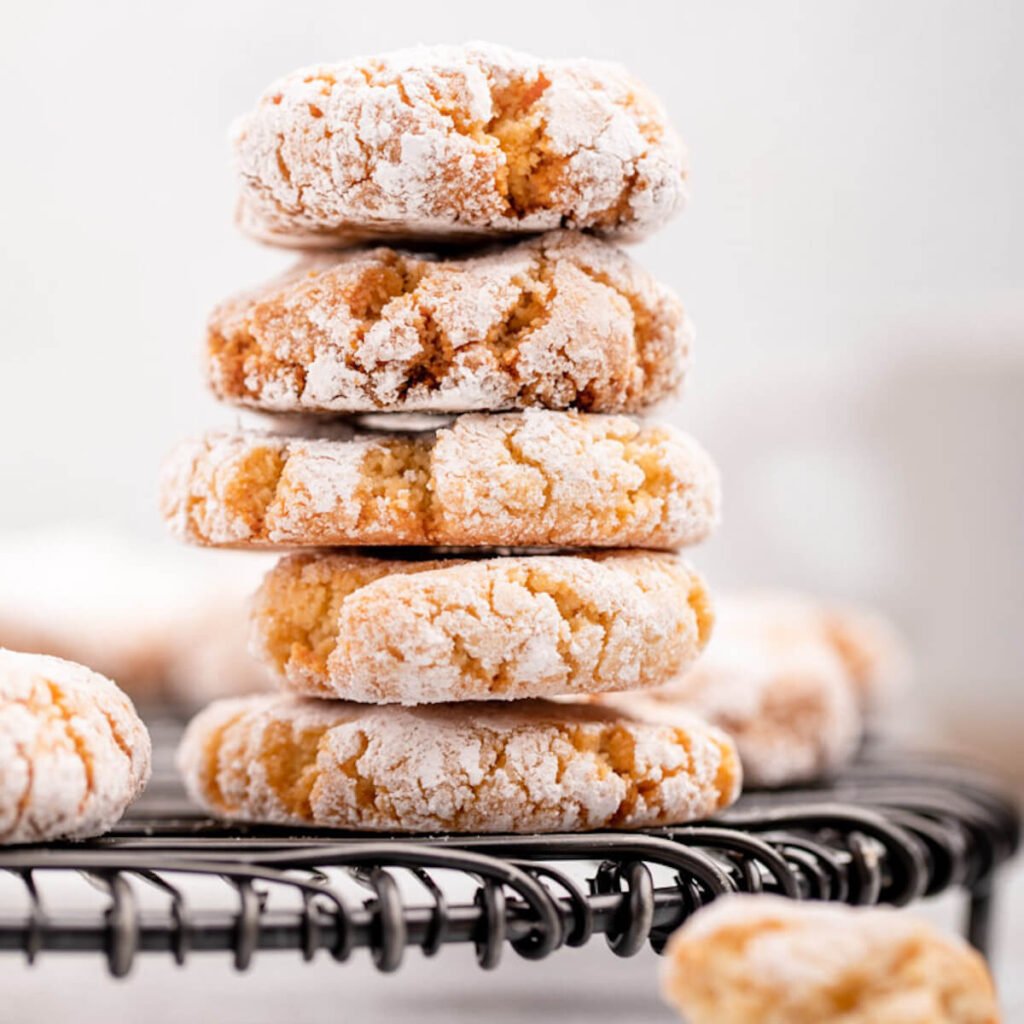
Amaretti cookies recipe are a classic Italian treat that have been enjoyed for centuries. These small, round cookies are made with almond flour, egg whites, and sugar, and are known for their crunchy exterior and chewy interior. In this article, we’ll take a closer look at the cultural significance and history of Amaretti cookies, as well as provide step-by-step instructions for making your own batch at home. Cultural Significance and History Amaretti cookies have been a part of Italian cuisine for over 300 years, with the first recorded recipe appearing in the mid-18th century. The name “Amaretti” comes from the Italian word “amaretto,” which means “little bitter.” This is because the cookies are traditionally made with bitter almonds, which have a slightly bitter taste. Over time, the recipe for Amaretti cookies has evolved, with many variations appearing across different regions of Italy. In some areas, the cookies are made with sweet almonds instead of bitter, while in others they are flavored with ingredients such as chocolate, lemon, or pistachio. Today, Amaretti cookies are enjoyed around the world as a sweet treat or as an ingredient in other desserts, such as cheesecake or tiramisu. Instructions for Making Classic Amaretti Cookies Making classic Amaretti cookies at home is easy, and requires just a few simple ingredients. Here’s what you’ll need: Step 1: Preheat your oven to 350 degrees Fahrenheit. Step 2: In a large mixing bowl, combine the almond flour, sugar, and salt. Step 3: In a separate mixing bowl, beat the egg whites until they are stiff peaks form. Add the almond extract and continue beating until the mixture is smooth. Step 4: Gradually fold the egg white mixture into the almond flour mixture, stirring gently until the two are fully combined. Step 5: Using a tablespoon, scoop out the cookie dough and form it into small, round balls. Place the balls onto a baking sheet lined with parchment paper. Step 6: Bake the cookies for 15-18 minutes, or until they are lightly golden brown on the outside. Step 7: Remove the cookies from the oven and allow them to cool on the baking sheet for a few minutes before transferring them to a wire rack to cool completely. Tips for Making the Perfect Amaretti Cookies Here are a few tips to help you make the perfect Amaretti cookies: Cooking Time and Nutritional Information The cooking time for classic Amaretti cookies is approximately 15-18 minutes, depending on your oven. In terms of nutritional information, each Amaretti cookie contains approximately: Amaretti cookies are also a good source of vitamin E and magnesium. Summary Amaretti cookies are a classic Italian treat that have been enjoyed for centuries. These small, round cookies are made with almond flour, egg whites, and sugar, and are known for their crunchy exterior and chewy interior. They have cultural significance in Italy and have been enjoyed as a sweet treat or as an ingredient in other desserts around the world. Making classic Amaretti cookies at home is easy and requires just a few simple ingredients. The process involves combining almond flour, sugar, and salt in a mixing bowl, beating egg whites in a separate bowl, and gradually folding the egg white mixture into the almond flour mixture until they are fully combined. Then, scoop out the cookie dough and form them into small, round balls and bake them for approximately 15-18 minutes at 350 degrees Fahrenheit. To make the perfect Amaretti cookies, it’s essential to use high-quality almond flour, not overmix the dough, and use a cookie scoop to form perfectly round balls of dough. Each Amaretti cookie contains approximately 80 calories, 4.5g of fat, 9g of carbohydrates, and 2g of protein. They are also a good source of vitamin E and magnesium. Conclusion In conclusion, the classic Amaretti cookies recipe is a delicious and easy way to experience a taste of Italian tradition. The cookies have cultural significance in Italy and have been enjoyed for centuries. Making them at home is simple and requires just a few basic ingredients. By following the instructions and tips provided in this article, you can create the perfect batch of Amaretti cookies that are crunchy on the outside and chewy on the inside. Plus, they are a good source of essential nutrients like vitamin E and magnesium. So why not try making a batch today and enjoy the taste of Italian tradition in your own home? More Italian Recipes Follow Us on Instagram
The Delicious Spaghetti Carbonara: A Classic Italian Pasta Dish
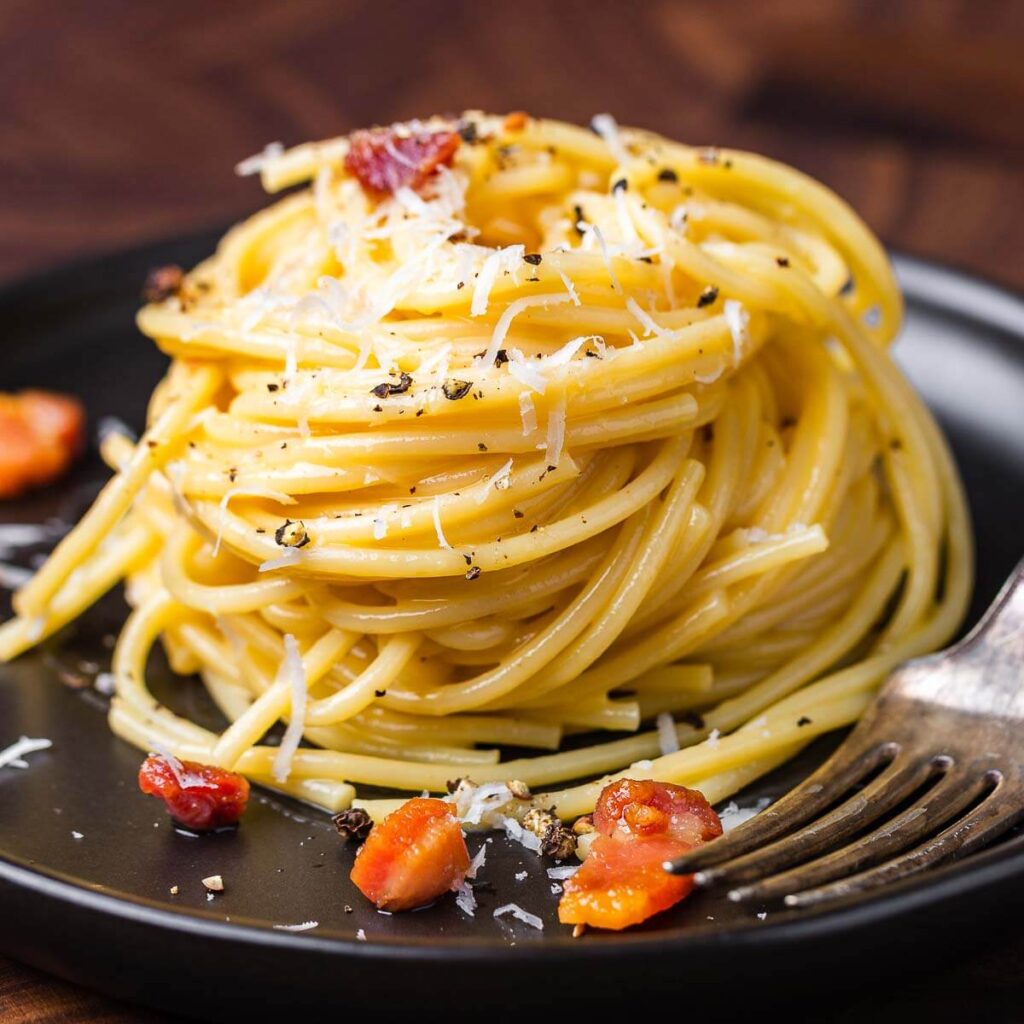
Spaghetti Carbonara is a classic Italian pasta dish made with spaghetti, eggs, pecorino Romano cheese, guanciale or pancetta, and black pepper. The dish originated in Rome, Italy and is a favorite among many pasta enthusiasts around the world. In this blog post, we will dive deeper into the recipe and history of Spaghetti Carbonara. Recipe for Spaghetti Carbonara Spaghetti Carbonara Ingredients: Spaghetti Carbonara Instructions: Cooking Time for Spaghetti Carbonara The total cooking time for Spaghetti Carbonara is approximately 20-25 minutes. It takes about 10-12 minutes to cook the spaghetti, and another 10-15 minutes to prepare the sauce and cook the guanciale or pancetta. History of Spaghetti Carbonara The origins of Spaghetti Carbonara are somewhat of a mystery, but it is believed to have originated in Rome in the mid-20th century. There are several theories on how the dish came to be, but the most common story involves American soldiers stationed in Italy during World War II. The soldiers were said to have brought bacon and powdered eggs with them, which they combined with spaghetti to create a new dish. Italians then added their own twist to the recipe, using guanciale or pancetta instead of bacon and fresh eggs instead of powdered ones. Another theory is that the dish was created by Italian coal miners, who would cook it over a fire using a piece of coal as a makeshift stove. The miners would combine eggs, cheese, and pasta to create a hearty and filling meal that would sustain them during their long shifts underground. Regardless of its origins, Spaghetti Carbonara has become a beloved dish in Italy and around the world. Its creamy, savory flavor and simple preparation make it a popular choice for pasta lovers everywhere. In conclusion, Spaghetti Carbonara is a classic Italian pasta dish that is easy to prepare and delicious to eat. Whether you’re looking for a quick and easy weeknight dinner or a special meal for a special occasion, Spaghetti Carbonara is a dish that will satisfy your pasta cravings. More European Recipes Follow Us on Instagram
Piroshki: A Delicious and Flavorful Eastern European Treat
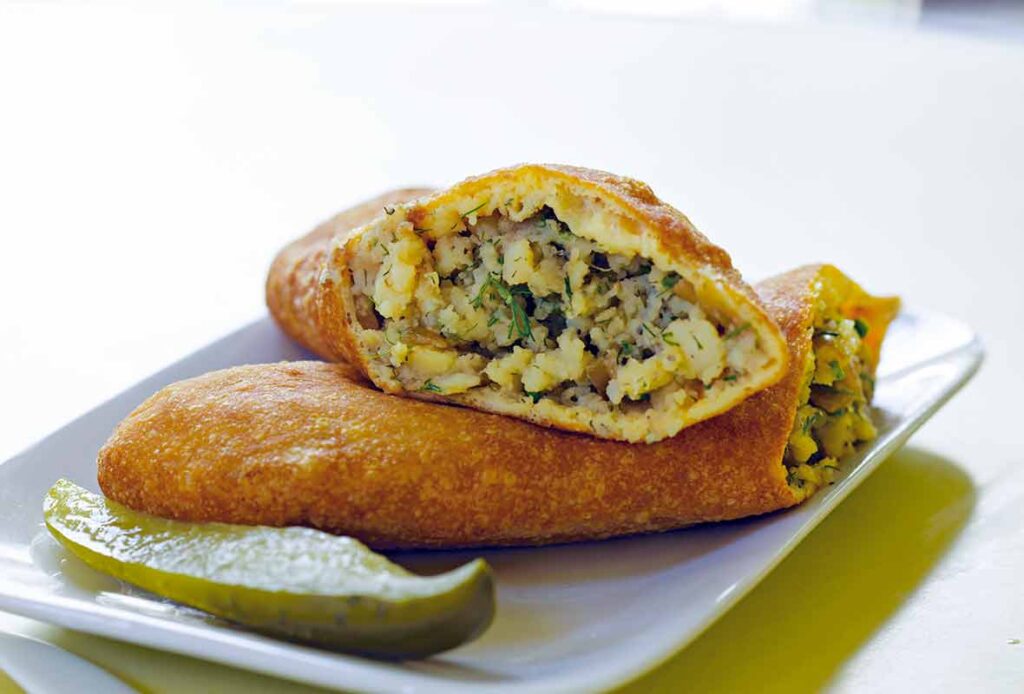
Piroshki is a popular Russian pastry that is enjoyed both as a snack and as a meal. These small pies are filled with a variety of savory or sweet fillings, and can be made with either yeast dough or shortcrust pastry. Piroshki can be baked or fried, and are often served with sour cream or other dipping sauces. In this post, we will explore the history and origins of piroshki, as well as provide a step-by-step guide on how to make them at home. History and Origins of Piroshki Piroshki have been a staple food in Russia and Eastern Europe for centuries. The word “piroshki” comes from the Russian word “pirogi,” which refers to any kind of filled pastry. These savory pastries were originally created as a way to use up leftover ingredients, and were often served during festivals and special occasions. Piroshki quickly became a popular food among peasants and the working class, as they were easy to transport and provided a filling and satisfying meal. As piroshki became more popular, different variations of the dish began to emerge. In some regions, piroshki are made with unleavened dough, while in others, they are made with a yeast dough. The fillings can also vary greatly, and can include meat, cheese, vegetables, and fruit. Today, piroshki are enjoyed not only in Russia and Eastern Europe, but also in other parts of the world. In the United States, piroshki are a popular food item in Russian and Eastern European communities, and can often be found at bakeries and restaurants. Recipe for Piroshki Now, let’s take a look at a simple recipe for piroshki that you can make at home. This recipe makes approximately 12 piroshki. Recipe for Piroshki Piroshki Ingredients: Cooking Time: Piroshki Instructions: Conclusion Piroshki is a delicious and satisfying dish that is perfect for a snack or a light meal. It is a popular dish in Eastern European cuisine and can be filled with a variety of ingredients, making it a versatile and customizable dish. With this recipe, you can make your own piroshki at home and enjoy the taste of traditional Eastern European cooking. More European Recipes Follow Us on Instagram
The Perfect Pairing: Bratwurst with Sauerkraut

Bratwurst with sauerkraut is a classic German dish that’s easy to make and packed with flavor. The juicy and savory bratwurst is perfectly complemented by the tangy and slightly sour taste of sauerkraut, making it a favorite among meat lovers. In this article, we’ll dive into the history of bratwurst and sauerkraut, as well as provide a recipe and cooking tips for this delicious and hearty dish. History of Bratwurst and Sauerkraut Bratwurst, which translates to “fried sausage” in German, has been a staple in German cuisine for centuries. The sausage is made with ground pork or beef, and is seasoned with an array of spices, including nutmeg, ginger, and caraway. Bratwurst is typically grilled or pan-fried, and is commonly served with mustard, sauerkraut, or potato salad. Sauerkraut, which means “sour cabbage” in German, is a fermented cabbage dish that has been a part of German cuisine for over 2,000 years. Sauerkraut is made by finely shredding cabbage and mixing it with salt, which allows the cabbage to ferment naturally. The fermentation process produces lactic acid, which gives sauerkraut its sour taste and also acts as a natural preservative. Recipe for Bratwurst with Sauerkraut Bratwurst with sauerkraut is a simple and easy-to-make dish that can be enjoyed any time of year. Here’s a classic recipe for bratwurst with sauerkraut: Bratwurst and Sauerkraut Ingredients: Bratwurst and Sauerkraut Instructions: Cooking Tips for Bratwurst with Sauerkraut Conclusion Bratwurst with sauerkraut is a classic German dish that’s perfect for any occasion. The combination of savory brat wurst and tangy sauerkraut is a perfect match, and the dish can be customized with various condiments and sides to suit your taste. Whether you’re looking for a quick weeknight dinner or a hearty meal for a special occasion, bratwurst with sauerkraut is sure to please. So why not try making this delicious and flavorful dish at home? With just a few simple ingredients and some basic cooking skills, you can create a meal that’s both satisfying and delicious. Just remember to use fresh ingredients, experiment with different spices and seasonings, and have fun in the kitchen. Prost! More European Recipes Follow Us on Instagram
Exploring the Rich and Hearty Goulash: A Classic Hungarian Dish
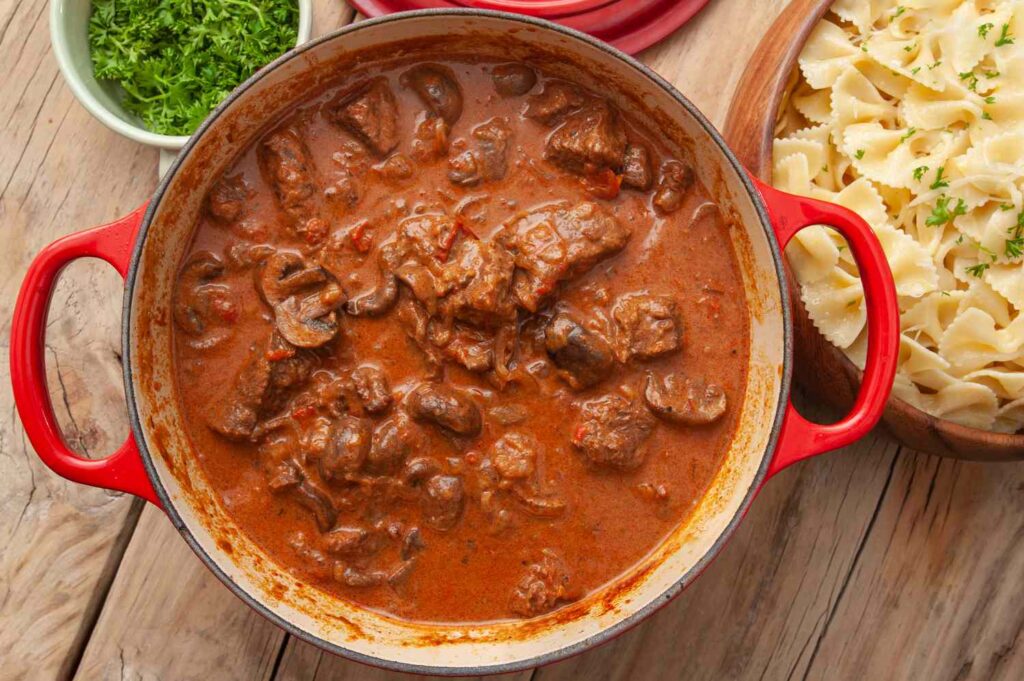
Goulash, also known as Hungarian goulash, is a rich and flavorful stew that originated in Hungary. It’s a popular comfort food that’s made with tender chunks of beef, vegetables, and an array of spices. This savory and hearty dish is perfect for cold weather and can be enjoyed on its own or with a side of bread or noodles. History of Goulash The origin of goulash can be traced back to the 9th century in Hungary, where it was primarily consumed by shepherds and herdsmen. Back then, the dish was made with meat, onions, and various spices, and was cooked over an open flame. Over the years, the recipe for goulash has evolved, and now includes ingredients like paprika and tomatoes. Today, goulash is considered a national dish in Hungary and is enjoyed by locals and tourists alike. Recipe for Goulash Goulash is a simple and easy-to-make dish that can be customized to your liking. Here’s a classic recipe for goulash: Goulash Ingredients: Goulash Instructions: Cooking Tips for Goulash Conclusion Goulash is a classic dish that’s packed with flavor and is a favorite among meat lovers. More European Recipes Follow Us on Instagram
The Classic Wiener Schnitzel: A Delicious Austrian Dish

Wiener Schnitzel, also known as “Viennese schnitzel,” is a classic Austrian dish that’s popular around the world. It’s made from thinly pounded and breaded veal cutlets, which are then fried to perfection. This delicious and filling dish is usually served with a side of potatoes, vegetables, or a salad. History of Wiener Schnitzel The origin of Wiener Schnitzel can be traced back to the 19th century in Vienna, Austria. The dish was originally made with pork, but it wasn’t until the 20th century that veal became the more popular choice of meat. Today, Wiener Schnitzel is considered to be a national dish of Austria, and is enjoyed by locals and tourists alike. Recipe for Wiener Schnitzel Wiener Schnitzel is a simple dish that can be made with just a few basic ingredients. Here’s a classic recipe for Wiener Schnitzel: Wiener Schnitzel Ingredients: Wiener Schnitzel Instructions: Cooking Tips for Wiener Schnitzel Conclusion Wiener Schnitzel is a classic dish that’s loved by many around the world. Its crispy and flavorful exterior, coupled with the tender and juicy meat, makes it a favorite among meat lovers. Whether you’re trying it for the first time or it’s one of your favorite dishes, Wiener Schnitzel is a must-try for anyone who enjoys hearty and delicious meals. More European Recipes Follow Us on Instagram
The Classic and Delicious Quiche Lorraine
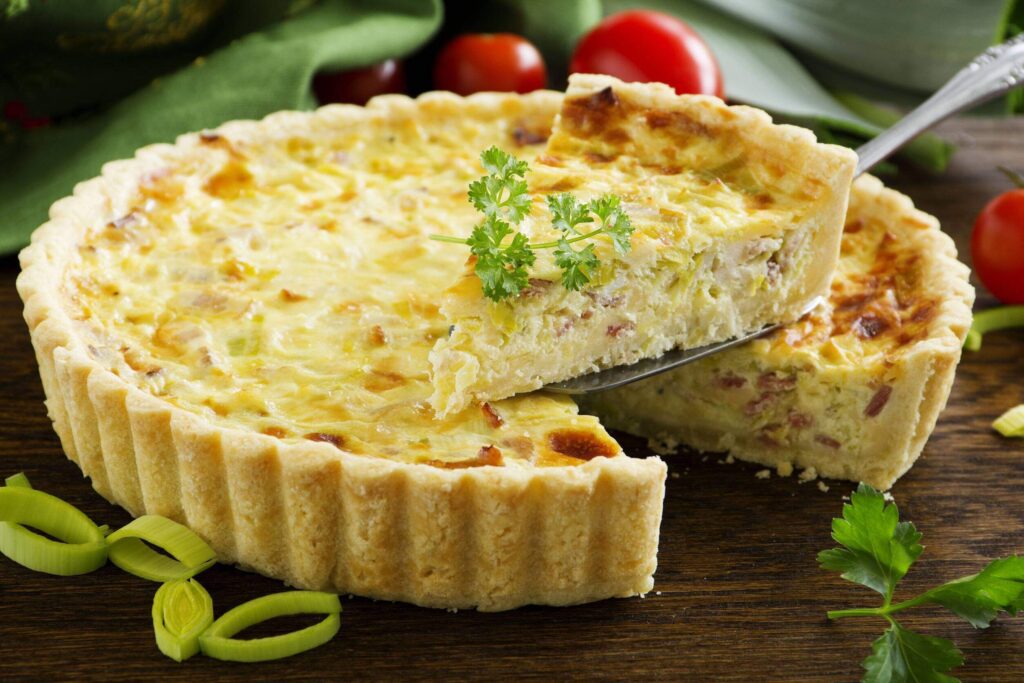
Quiche Lorraine is a savory pie that originated in the region of Lorraine, France. This classic dish is made with a pastry crust, a filling of eggs and cream, and typically includes bacon or ham, cheese, and onions. It’s a delicious and versatile dish that can be served as a main course for lunch or dinner, or as an appetizer or snack. History of Quiche Lorraine The origin of quiche can be traced back to the Middle Ages in the region of Lorraine, which is now part of northeastern France. The word “quiche” comes from the German word “kuchen,” which means cake, and it’s believed that the dish was first made with bread dough and filled with eggs, cream, and bacon or ham. Over time, the recipe for quiche evolved, with the addition of cheese and other ingredients. It wasn’t until the 20th century that quiche became popular outside of France, thanks to cookbooks and food writers who helped spread the word about this delicious dish. Recipe for Quiche Lorraine Quiche Lorraine is a simple and easy dish to make, with just a few basic ingredients. Here’s a classic recipe for quiche Lorraine: Ingredients: Instructions: Cooking Tips for Quiche Lorraine Conclusion Quiche Lorraine is a classic French dish that’s loved by many around the world. It’s a versatile and delicious dish that’s perfect for any occasion, from a casual lunch with friends to a formal dinner party. With its buttery crust, creamy filling, and savory ingredients, quiche Lorraine is a must-try for any food lover. More European Recipes Follow Us on Instagram
Fish and Chips: A Classic British Dish

Fish and chips is a classic British dish that has been enjoyed for over a century. This dish consists of battered fish that’s deep-fried until crispy, served with hot, crispy fries or chips. It’s a comforting and satisfying meal that’s perfect for a night in or a quick lunch on the go. Fish and Chips Recipe Here’s a recipe for fish and chips that you can try at home: Fish and Chips Ingredients For the fish: For the chips: Fish and Chips Instructions Fish and Chips Cooking Time The total cooking time for fish and chips is around 30-45 minutes. However, the preparation time can be longer if you’re making the fries from scratch. The key to perfect fish and chips is to make sure the oil is at the right temperature, so the batter crisps up and the fish cooks through without getting greasy. Tips for Making the Perfect Fish and Chips Here are a few tips to keep in mind when making fish and chips: Variations on the Classic Fish and Chips Recipe While the classic fish and chips recipe is made with white fish and fries, there are many variations on this dish. For example, you can use different types of fish, such as salmon or tilapia, or swap the fries for a side salad. Some recipes also call for beer batter or seasoned flour for the fish, or a variety of dipping sauces like garlic aioli or sweet chili sauce History of Fish and Chips Fish and chips has a long and interesting history, with various theories on how this iconic dish originated. One popular theory is that it was created in the 19th century by Jewish immigrants who settled in the East End of London. They began selling fried fish, which was a popular food in the Jewish community, with chips or fried potatoes as a cheap and filling side dish. The dish quickly caught on, and by the early 20th century, fish and chips shops, or “chippies,” were a common sight throughout the UK. During World War II, fish and chips became a staple food for the British population due to rationing and shortages. It was one of the few foods that wasn’t rationed and was widely available, making it a popular and affordable meal for many families. Today, fish and chips remains a beloved dish in the UK, and it’s also popular in other countries, including Australia and New Zealand, where it’s often served with tartar sauce and lemon wedges. Health Benefits of Fish and Chips While fish and chips may not be the healthiest dish, it does have some nutritional benefits. Fish is a great source of protein and omega-3 fatty acids, which are important for heart health and brain function. Potatoes are also a good source of complex carbohydrates, fiber, and vitamins and minerals. To make fish and chips a bit healthier, you can try using a lighter batter, such as a beer batter, which is less greasy than traditional batter. You can also use a healthier type of oil, such as olive oil or coconut oil, for frying the fish and chips. Conclusion Fish and chips is a classic British dish that’s loved by many around the world. It’s a simple and satisfying meal that’s perfect for a quick lunch or a cozy dinner at home. Whether you’re a fan of the classic recipe or prefer to experiment with different types of fish or sides, there’s no denying that fish and chips is a delicious and comforting dish that will always be a favorite. More European Recipes Follow Us on Instagram
